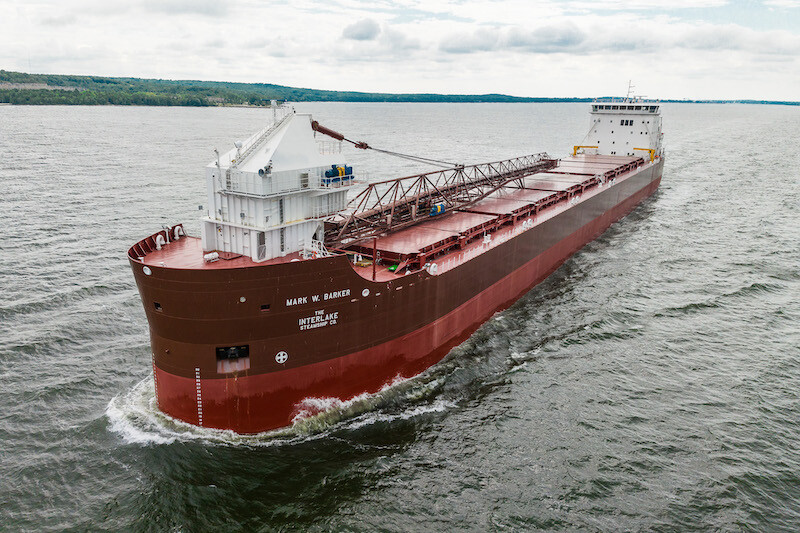A new U.S.-flagged Great Lakes bulk carrier has been delivered for the first time in more than 35 years.
In 2019, the Interlake Steamship Company awarded a contract to Fincantieri Bay Shipbuilding to build a new River-class, self-unloading bulk carrier.
It is believed to be the first ship for U.S. Great Lakes service built on the Great Lakes since 1983. The ship will transport raw materials to support manufacturing throughout the Great Lakes region.
The 639'x78'x45', 28,000-dwt Mark W Barker was built at Bay Ship in Sturgeon Bay, Wis. Interlake Steamship, Middleburg Heights, Ohio, is the largest privately held U.S.-flag fleet on the Great Lakes, with nine vessels that carry bulk cargoes. It's newest vessel, until now, the Paul R. Tregurtha, was built at American Ship Building Co., Lorain, Ohio, in 1981. The 1,013'x105'x56' vessel has a capacity of 68,000 tons and is the longest vessel on the Great Lakes.
Bay Engineering Inc., Sturgeon Bay, designed the Mark W Barker bulk carrier, complete with advanced vessel and unloading systems automation.
With a draft of 29'1-7/8", the new self-unloading bulk carrier has a unique cargo hold arrangement and cargo hatch covers designed for maximum cubic space and the ability to handle difficult cargoes. The vessel incorporates a flap rudder as well as bow and stern thrusters for high-level maneuverability.
There is “added protection from damage such as double bottom and side shell voids above damage stability requirements, sliding cargo bulkhead door forward and aft garages with garage door access to cargo holds for storage of two Caterpillar 938M front end loaders and two T870 Bobcats box girder system with only a single transverse bulkhead,” said Travis Martin, president, Bay Engineering.
The new bulk carrier is a gravity, self-unloading/mechanical unloading vessel used for hauling cargoes of salt, coal, iron ore pellets, stone, sand, and hot briquette iron (HBI). It’s design also allows for carrying unique cargo on spur deck hatch covers.
The 15,507 grt. Mark W Barker’s main propulsion comes from two 16-cylinder EMD 16ME23B Tier 4 (IMO Tier III) diesel engines, producing 4,000 hp at 900 rpm each. The mains are connected to Kongsberg KeMeWa 4-bladed controllable pitch propellers built to Ice 1C standards (but not classed) through Lufkin CSQ11400-5-PTO marine gears with 7.5:1 reduction ratios. The vessel is expected to have a top speed in excess of 15 mph. “Engines will be complete with accessory rack and vibration mounts,” said Martin.
The Mark W Barker was fitted with two Kongsberg thrusters for added maneuverability — one bow and one stern. Kongsberg also handles the steering system and controls duties for the new bulk carrier.
Tankage includes 109,077 gals. of diesel fuel; 16,939 gals. potable water; 6,444 gals. urea; 7,504 gals. lube oil; and 19,770 gals. effluents.
For electrical power, there's a Caterpillar C32 ACERT marine package genset rated at 940-kW, two 2,500-kW shaft generators and one 274-kW emergency generator.
Mark W Barker is ABS classed Maltese Cross A1, bulk carrier for service on the Great Lakes, St. Lawrence River Service, circle E, AMS,ACCU, CGSU, UWILD and USCG, Subchapter I (cargo vessel).
“When we approached a historic project of this magnitude — building our company’s first ship since 1981 — we knew it was critical to choose the right partners," Interlake President Mark W. Barker said in a statement announcing the contract in 2019. "Fincantieri Bay Shipbuilding is the shipyard that has the experience and skill to execute on our long-term vision. We’ve had a long and positive relationship of partnering with Fincantieri Bay Shipbuilding as we have modernized and reinvested heavily in our fleet. They have skillfully handled four repowers, five exhaust gas scrubber installations, as well as regular maintenance and regulatory drydockings on our vessels.”




